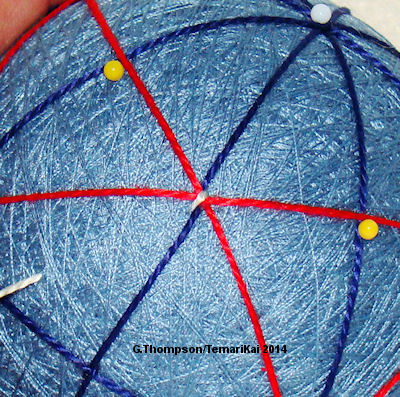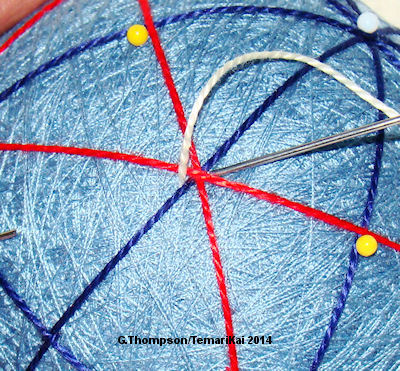Tack Stitch
Tack stitches are used so often in temari making that they deserve some attention. Technically, a tack stitch is simply kagari.
 However, the orientation of
it based on need is just as important as the actual stitch size. When
used to hold threads in place such as described here, it can also be
known as tabane kagari.
However, the orientation of
it based on need is just as important as the actual stitch size. When
used to hold threads in place such as described here, it can also be
known as tabane kagari. Tack stitches are used to hold centers and other intersections in place on divisions and markings. As such, they should be as unobtrusive as possible. This is accomplished through use of a tiny stitch size, and tight placement at the intersection of the marking line. Notice in the example below (granted, this is worked in highly contrasting thread for demonstration purposes) that the tacking thread is brought up tightly in the corner of the intersection of the marking lines. It is then carried diagonally over the intersection, so that an equal number of marking lines are on either side of it. This assures that the intersection of the marking threads will be tight and secure (do not confuse tight with pulling the tacking
 thread tight. Normal tension is still
used), and clean without disturbing the lay of the threads.
thread tight. Normal tension is still
used), and clean without disturbing the lay of the threads. Normally tacking is done with the same thread as what is being anchored; that is, marking threads are tacked with the same thread used to mark the ball. However, some people will use a piece of regular sewing thread, or a single strand of floss as tacking thread. The smaller size makes for an even more invisible anchor. This is especially notable if the marking thread is of a large gauge; tacking with the same thread can create a noticeable lump.
The tack stitch is taken into the mari; it's not just passing under the marking or stitching threads and gathering them into a crisp center. That is one half of its purpose. The other half and perhaps more important is to hold that intersection point accurately and securely on the mari (especially in the case of division threads), without impacting the placement of the center.
Tack stitches also play an important role in matsuba kagari. In order to achieve the star burst effect so often desired, a distinct center is needed. This is achieved by tacking the center intersection. Care should always be taken to be sure that an equal number of stitching threads are on either side of the stitch; this is what gives clear resolution to the center, and avoids skewing the appearance of the reach of the stitch.
This
is a TemariKai.com Printable Page; © 2014, all rights reserved.
Right click to print one copy for personal use.
Last updated 1/2014 © 1998 - 2014 TemariKai.com, G. Thompson/PuffinStuff, Inc.
